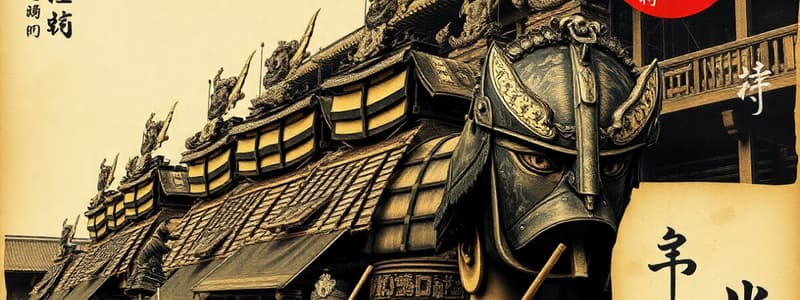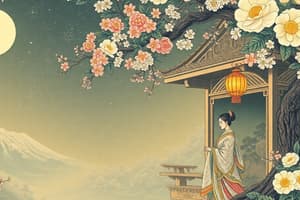Podcast
Questions and Answers
Which factor most significantly hindered early Japan's interaction with other civilizations?
Which factor most significantly hindered early Japan's interaction with other civilizations?
- Japan's remote geographical location as an island nation. (correct)
- A lack of navigable rivers for internal transport.
- A strict policy of isolationism enforced by powerful clans.
- The absence of a centralized government to manage foreign relations.
Unlike the Chinese, the early Japanese passed down myths and legends, which significantly shaped their culture. Historical record-keeping was not a primary focus.
Unlike the Chinese, the early Japanese passed down myths and legends, which significantly shaped their culture. Historical record-keeping was not a primary focus.
True (A)
Explain how the Yamato clan used mythology to legitimize their rule and establish a unified Japanese state.
Explain how the Yamato clan used mythology to legitimize their rule and establish a unified Japanese state.
The Yamato clan claimed direct descent from Jimmu Tenno, the first emperor and descendant of the sun goddess, positioning themselves as divine rulers and securing loyalty from other clans.
The Taika Reform aimed to emulate the ______ dynasty's centralized government, but in practice, powerful families like the Fujiwara controlled key government posts.
The Taika Reform aimed to emulate the ______ dynasty's centralized government, but in practice, powerful families like the Fujiwara controlled key government posts.
Match the following elements of Chinese culture with their impact on Japan:
Match the following elements of Chinese culture with their impact on Japan:
Which of the following statements best characterizes the role of the emperor in Japanese history?
Which of the following statements best characterizes the role of the emperor in Japanese history?
The Bushido code, which governed the conduct of the samurai, was a formally written and legally enforced set of rules.
The Bushido code, which governed the conduct of the samurai, was a formally written and legally enforced set of rules.
How did the rise of the samurai and the establishment of the shogunate fundamentally alter the political landscape of Japan?
How did the rise of the samurai and the establishment of the shogunate fundamentally alter the political landscape of Japan?
The practice of ______, a ceremonial suicide, was a way for a samurai to avoid disgrace, atone for misconduct, or demonstrate loyalty to his master.
The practice of ______, a ceremonial suicide, was a way for a samurai to avoid disgrace, atone for misconduct, or demonstrate loyalty to his master.
Which of the following aspects of Shintoism most directly supported the authority of the Japanese emperor?
Which of the following aspects of Shintoism most directly supported the authority of the Japanese emperor?
What was the primary motivation behind the Taika Reform in mid-seventh century Japan?
What was the primary motivation behind the Taika Reform in mid-seventh century Japan?
The Japanese actively welcomed Chinese culture, particularly during the Tang dynasty, viewing it as superior. This was a cultural rather than a military invasion.
The Japanese actively welcomed Chinese culture, particularly during the Tang dynasty, viewing it as superior. This was a cultural rather than a military invasion.
Explain the significance of Prince Shotoku in the context of the transmission of Chinese culture to Japan.
Explain the significance of Prince Shotoku in the context of the transmission of Chinese culture to Japan.
Following the Taika Reform, the Japanese established their first permanent capital at ______, modeled after the main city of China.
Following the Taika Reform, the Japanese established their first permanent capital at ______, modeled after the main city of China.
Match the following elements of the samurai's Bushido code with their meanings:
Match the following elements of the samurai's Bushido code with their meanings:
Flashcards
Japan Geography
Japan Geography
Island nation off the coast of Asia, consisting of four main islands and hundreds of lesser ones.
Japanese Clan
Japanese Clan
Group of families claiming descent from a common ancestor, serving as the basic unit of social, religious, and political organization in early Japan.
Yamato Clan
Yamato Clan
Clan that rose to power in the fifth century AD and forged a unified Japanese state.
Jimmu Tenno
Jimmu Tenno
Signup and view all the flashcards
Shintoism
Shintoism
Signup and view all the flashcards
Chinese Cultural Invasion
Chinese Cultural Invasion
Signup and view all the flashcards
Chinese Writing System in Japan
Chinese Writing System in Japan
Signup and view all the flashcards
Buddhism in Japan
Buddhism in Japan
Signup and view all the flashcards
Taika Reform
Taika Reform
Signup and view all the flashcards
Shogun
Shogun
Signup and view all the flashcards
Samurai
Samurai
Signup and view all the flashcards
Bushido
Bushido
Signup and view all the flashcards
Hara-kiri
Hara-kiri
Signup and view all the flashcards
Study Notes
- Japan is an island nation off the coast of Asia, opposite China, Korea, and Siberia, consisting of four main islands and hundreds of smaller ones.
- Japan's land area is approximately the size of California, though most of it is mountainous, with less than 20% suitable for farming.
- Until the late nineteenth century, Japan remained isolated from the world's civilizations
- Early Japanese history was passed down through myths and legends, shaping Japanese culture.
- Japanese mythology says god Izanagi and goddess Izanami created the islands of Japan.
- Early Japan was divided by warring clans, with each clan having its own land, god, and chieftain.
- By the fifth century AD, the Yamato clan, centered on Honshu, gained power and unified Japan.
- The Yamato clan used Japanese mythology to secure the loyalty of other clan chieftains.
- According to legend, the first emperor of Japan, Jimmu Tenno, was a direct descendant of the sun goddess.
Imperial Family
- The Yamato clan claimed its rulers were descendants of Jimmu Tenno, believed to be divine.
- The imperial family of Japan arose from this clan.
- Japan has had only one imperial family, serving as a symbol of unity and continuity.
Shintoism
- Shintoism, Japan's native religion, supported the belief in the divine origin of the emperor.
- Shintoism was originally a form of nature worship, attributing deity to awe-inspiring natural elements.
- Shintoism stressed the supremacy of the sun goddess and the divine descent of the emperor.
- It inspired love for homeland, loyalty to clan, and reverence for the emperor.
Chinese Influence
- From the fifth to the eighth centuries, Chinese culture, ideas, learning, and art greatly influenced Japan.
- The Chinese writing system was adopted and adapted by the Japanese, enabling them to keep written records and produce their own literature.
- Chinese culture flowed into Japan through Buddhism, with Buddhist monks teaching the Japanese about Chinese art and way of life.
- Prince Shotoku made Buddhism the favored national religion in the seventh century, leading to the construction of temples, hospitals, and schools.
- Japan borrowed China's writing, literature, religion, weights and measures, medical practices, calendar, furniture styles, dress, and construction methods.
Taika Reform
- In the mid-seventh century, Japanese leaders modeled their government after the Tang dynasty's centralized bureaucracy.
- The Taika Reform aimed to weaken clan chieftains and extend the emperor's power.
- Japan established civil service examinations, a judicial code, and a tax system, and built its first permanent capital at Nara.
- Government authority shifted to powerful families like the Fujiwara, who controlled key government posts.
- The Fujiwara family married their daughters into the imperial family and ruled as regents of infant emperors.
Rise of Samurai
- Corruption and bankruptcy followed the luxurious life of the royal court, leading to disorder.
- Provincial governors relied on strong military clans for protection, causing power struggles.
- In the twelfth century, Yoritomo of the Minamoto clan became the supreme military leader, or shogun.
- From 1192 to 1868, powerful shoguns held real power over the Japanese government.
- With the rise of the shogun, the warrior class became the leading class in Japanese society.
- The Japanese warrior was called a samurai, mastering military skills and studying history, literature, and writing.
- The Bushido code governed the conduct of the samurai, emphasizing loyalty, honor, duty, justice, courage, sincerity, and politeness.
- Samurai could commit hara-kiri to avoid disgrace, atone for misconduct, or resolve questions of loyalty.
Studying That Suits You
Use AI to generate personalized quizzes and flashcards to suit your learning preferences.




